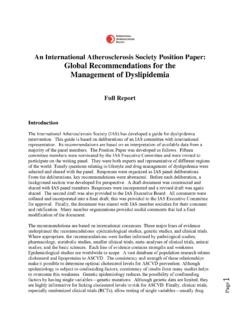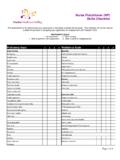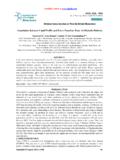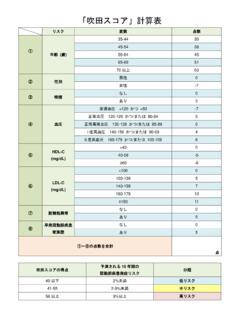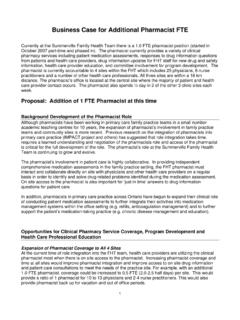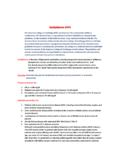Transcription of CHAPTER 8 ANTIHYPERTENSIVE DRUGS Classification
1 CHAPTER 8. ANTIHYPERTENSIVE DRUGS . Classification 1. Diuretics. 2. Beta adrenergic blockers. 3. Calcium channel blockers. 4. Angiotensin converting enzyme inhibitors. 5. Angiotensin receptor blockers. 6. Sympatholytics and adrenergic blockers. 7. Direct arterial vasodilators. Types Thiazides and related diuretics. Loop diuretics. Potassium sparing diuretics. Mechanism of Action Initial effects: through reduction of plasma volume and cardiac output. Long term effect: through decrease in total peripheral vascular resistance. Advantages Documented reduction in cardiovascular morbidity and mortality.
2 Least expensive ANTIHYPERTENSIVE DRUGS . Best drug for treatment of systolic hypertension and for hypertension in the elderly. Can be combined with all other ANTIHYPERTENSIVE DRUGS to produce synergetic effect. Side Effects Metabolic effects (uncommon with small doses): hypokalemia, hypomagnesemia, hyponatremia, hyperuricemia, dyslipidemia (increased total and LDL cholesterol), impaired glucose tolerance, and hypercalcemia (with thiazides). Postural hypotension. Impotence in up to 22% of patients. Practical Considerations Moderate salt restriction is the key for effective ANTIHYPERTENSIVE effect of diuretics and for protection from diuretic - induced hypokalaemia.
3 Thiazides are not effective in patients with renal failure (serum creatinine >. 2mg /dl) because of reduced glomerular filtration rate. Frusemide needs frequent doses ( 2-3 /day ).Thiazides can be given once daily or every other day. Potassium supplements should not be routinely combined with thiazide or loop diuretics. They are indicated with hypokalemia (serum potassium < mEq/L) especially with concomitant digitalis therapy or left ventricular hypertrophy. Nonsteroidal antiinflammatory DRUGS can antagonize diuretics effectiveness. Special Indications Diuretics should be the primary choice in all hypertensives.
4 They are indicated in: - Volume dependent forms of hypertension: blacks, elderly, diabetic, renal and obese hypertensives. - Hypertension complicated with heart failure. - Resistant hypertension: loop diuretics in large doses are recommended. - Renal impairment: loop diuretics. Preparations and Dosage: see table 12. 2. Beta - Adrenergic Blocking Agents Mechanisms of Action Initial decrease in cardiac output, followed by reduction in peripheral vascular resistance. Other actions include decrease plasma renin activity, resetting of baroreceptors, release of vasodilator prostaglandins, and blockade of pre- junctional beta-receptors.
5 Advantages Documented reduction in cardiovascular morbidity and mortality. Cardioprotection: primary and secondary prevention against coronary artery events ( ischemia, infarction, arrhythmias, death). Relatively not expensive. Practical Considerations Beta blockers are used with caution in patients with bronchospasm. Contraindicated in more than grade I AV, heart block. Do not discontinue abruptly. Side Effects Bronchospasm and obstructive airway disease. Bradycardia Metabolic effects (raise triglyerides levels and decrease HDL cholesterol; may worsen insulin sensitivity and cause glucose intolerance).
6 Increased incidence of diabetes mellitus. Coldness of extremities. Fatigue. Mask symptoms of hypoglycemia. Impotence. Special Indications First line treatment for hypertension as an alternative to diuretics. Hypertension associated with coronary artery disease. Hyperkinetic circulation and high cardiac output hypertension ( , young hypertensives). Hypertension associated with supraventricular tachycardia, migraine, essential tremors, or hypertrophic cardiomyopathy. Preparations and Dosages: see table 12. 3. Calcium channel blockers Types Dihydropyridine: nifedipine, amlodipine, felodipine, nicardipine, lacidipine.
7 Non dihydropyridine : - Phenylalkylamine: verapamil. - Benzothiazepine: diltiazem. Mechanisms of action Decrease in the concentration of free intracellular calcium ions results in decreased contraction and vasodilation. Diuretic effect through increase in renal blood flow and glomerular filtration rate. Inhibition of aldosterone secretion. Advantages No metabolic distrubances: no change in blood glucose, potassium, uric acid and lipids. May improve renal function. Maintain optimal physical, mental, and sexual activities. Special Indications Ischemic heart disease: when beta blockers are ineffective or contraindicated and in vasospastic angina.
8 Elderly hypertensives: second agent of choice after diuretics. Peripheral vascular disease ( , Raynauld`s phenomenon). Side Effects Dihydropyridine: flushing, headache, and lower limb oedema. Non dihydropyridine: aggravation of heart failure and heart block. Verapamil may cause constipation. Practical Considerations Short acting dihydropyridine should be combined with beta blockers in coronary artery disease, and should be avoided in stroke, and hypertensive crisis. Peparations and Dosages: see table 12. 4. Angiotensin Converting Enzyme Inhibitors Types Class I: captopril Class II (prodrug) : , ramipril, enalapril, perindopril Class III ( water soluble) : lisinopril.
9 Mechanism of Action Inhibition of circulating and tissue angiotensin- converting enzyme. Increased formation of bradykinin and vasodilatory prostaglandins. Decreased secretion of aldosterone; help sodium excretion. Advantages Reduction of cardiovascular morbidity and mortality in patients with atherosclerotic vascular disease, diabetes, and heart failure. Favorable metabolic profile. Improvement in glucose tolerance and insulin resistance. Renal glomerular protection effect especially in diabetes mellitus. Do not adversely affect quality of life. Special Indications Diabetes mellitus, particularly with nephropathy.
10 Congestive heart failure. Following myocardial infraction. Side Effects Cough (10 - 30%): a dry irritant cough with tickling sensation in the throat. Skin rash (6%). Postural hypotension in salt depleted or blood volume depleted patients. Angioedema ( ) : life threatening. Renal failure: rare, high risk with bilateral renal artery stenosis. Hyperkalaemia Teratogenicity. Practical Considerations Contraindications include bilateral renal artery stenosis, pregnancy, known allergy, and hyperkalaemia. High serum creatinine (> 3 mg/dl) is an indication for careful monitoring of renal function, and potassium.
